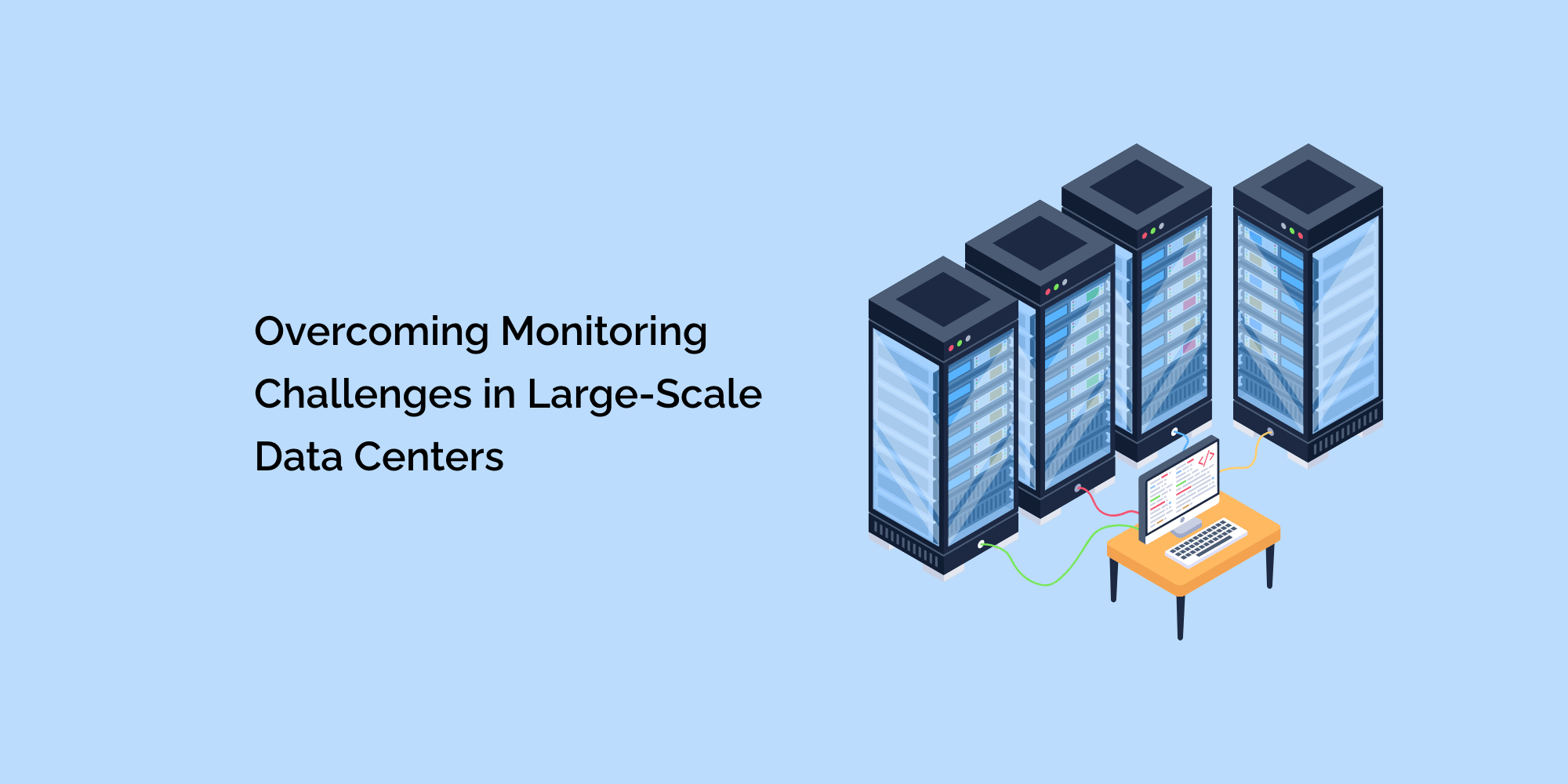Large-scale data centers serve as the backbone of the digital infrastructure, housing massive amounts of critical data and supporting numerous services and applications. Effective monitoring is essential to ensure optimal performance, reliability, and security in these complex environments. However, monitoring challenges arise due to the scale and complexity of data centers, making it crucial to develop strategies to overcome them.
In this blog, we will explore the monitoring challenges faced in large-scale data centers and provide practical solutions to enhance monitoring efficiency and effectiveness.
Understanding Monitoring Challenges in Large-Scale Data Centers
Scale and Complexity
Unique challenges posed by the vast size of large-scale data centers
Complexity resulting from a multitude of interconnected systems and components
The impact of scale on monitoring accuracy and real-time visibility
Diverse Infrastructure and Equipment
Varied types of servers, storage systems, networking devices, and power infrastructure
Compatibility and integration challenges among different equipment
The need for comprehensive monitoring coverage across diverse infrastructure elements
Data Overload and Noise
Massive amounts of data generated from numerous monitoring sources
Challenges in processing, analyzing, and extracting meaningful insights from data
Filtering out irrelevant noise and focusing on actionable information
Strategies for Effective Monitoring in Large-Scale Data Centers
Centralized Monitoring and Management
Establishing a centralized monitoring system for comprehensive visibility
Integration of multiple monitoring tools and platforms into a unified dashboard
Automation and correlation of data to provide a holistic view of the data center
Scalable Monitoring Architecture
Designing a monitoring infrastructure that can scale with the data center's growth
Implementing distributed monitoring points for comprehensive coverage
Utilizing cloud-based monitoring solutions for scalability and flexibility
Real-time Monitoring and Alerting
Implementing real-time monitoring capabilities for prompt issue detection
Setting up proactive alerts and notifications for critical events
Leveraging AI and machine learning to identify anomalies and patterns in data
Data Consolidation and Analysis
Consolidating monitoring data from diverse sources into a centralized repository
Utilizing advanced analytics to extract meaningful insights and trends
Employing visualization techniques for better data comprehension and decision-making
Security and Compliance Monitoring
Implementing robust security monitoring solutions to detect threats and vulnerabilities
Adhering to compliance requirements through continuous monitoring and auditing
Incorporating anomaly detection and behavior analytics for proactive security measures
Best Practices for Monitoring in Large-Scale Data Centers
Comprehensive Asset Management
Maintaining an accurate inventory of equipment and infrastructure components
Tracking asset utilization, performance, and lifecycle management
Integration with monitoring systems for seamless visibility and tracking
Performance Baseline and Trend Analysis
Establishing performance baselines for different infrastructure elements
Analyzing trends and patterns to predict potential issues
Capacity planning based on historical data and future projections
Continuous Monitoring Process Improvement
Conducting regular reviews and audits of monitoring processes
Identifying areas for improvement and implementing corrective measures
Fostering a culture of continuous monitoring enhancement and optimization
Collaboration and Knowledge Sharing
Facilitating cross-team collaboration for effective monitoring practices
Sharing insights, best practices, and lessons learned among monitoring teams
Encouraging knowledge transfer and professional development
Utilizing Advanced Monitoring Technologies
Internet of Things (IoT) Sensors
- Deploying IoT sensors for granular environmental monitoring
- Tracking temperature, humidity, airflow, and power consumption
- Integration with monitoring systems for real-time data analysis
Machine Learning and Artificial Intelligence (AI)
- Harnessing the power of AI and machine learning for predictive monitoring
- Analyzing historical data to identify patterns and anomalies
- Automated root cause analysis and proactive issue resolution
Software-Defined Networking (SDN) and Network Function Virtualization (NFV)
- Leveraging SDN and NFV technologies for enhanced network monitoring
- Centralized control and visibility of network traffic and performance
- Dynamic provisioning of monitoring resources for scalability and agility
Blockchain Technology for Auditability
- Utilizing blockchain for tamper-proof monitoring data storage
- Ensuring data integrity and auditability of monitoring records
- Transparent and verifiable monitoring data for compliance purposes
Ensuring Resilience and Redundancy in Monitoring
Redundant Monitoring Systems and Power Supply
- Implementing redundant monitoring systems for fault tolerance
- Ensuring backup power supply to sustain monitoring during outages
- Automatic failover mechanisms for uninterrupted monitoring coverage
Disaster Recovery and Business Continuity Planning
- Incorporating monitoring into disaster recovery and business continuity plans
- Identifying critical monitoring points and ensuring their redundancy
- Regular testing and validation of monitoring systems in disaster scenarios
Monitoring High-Density and Virtualized Environments
- Addressing monitoring challenges in high-density data centers
- Utilizing specialized tools for monitoring virtualized infrastructure
- Granular visibility into virtual machines and containers for accurate monitoring
Continuous Monitoring Health Checks
- Regularly assessing the health and performance of monitoring systems
- Monitoring system monitoring to ensure its accuracy and reliability
- Implementing proactive maintenance and upgrades to avoid system failures
Staff Training and Knowledge Management
Providing Comprehensive Training Programs
- Offering training on monitoring tools, technologies, and best practices
- Continuous education to keep monitoring staff updated with industry advancements
- Encouraging certifications and professional development opportunities
Building a Knowledge Base and Documentation
- Creating a centralized knowledge base for monitoring procedures and troubleshooting
- Documenting monitoring configurations, thresholds, and processes
- Regularly updating documentation to reflect changes and lessons learned
Conclusion
Overcoming monitoring challenges in large-scale data centers requires a combination of advanced technologies, redundancy measures, and continuous improvement. By leveraging IoT sensors, AI, SDN, and blockchain, organizations can enhance their monitoring capabilities and gain deeper insights into the data center's performance.
Ensuring resilience and redundancy in monitoring systems safeguards against failures, while staff training and knowledge management maintain a skilled workforce equipped with the latest monitoring tools and practices.
By implementing these strategies and fostering a culture of innovation and continual learning, organizations can effectively overcome monitoring challenges, optimize data center performance, and ensure the availability and reliability of their critical infrastructure.








